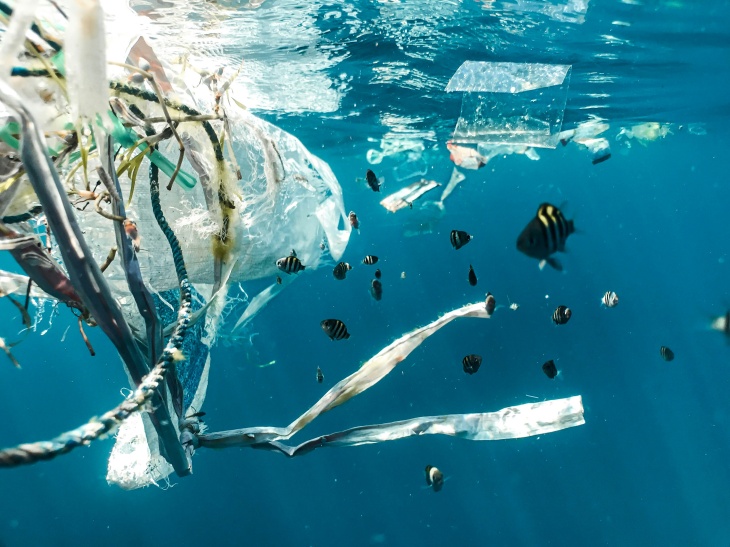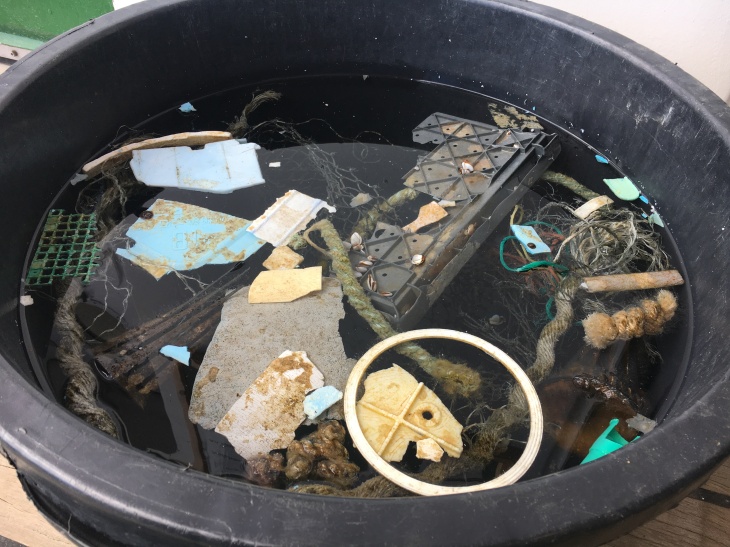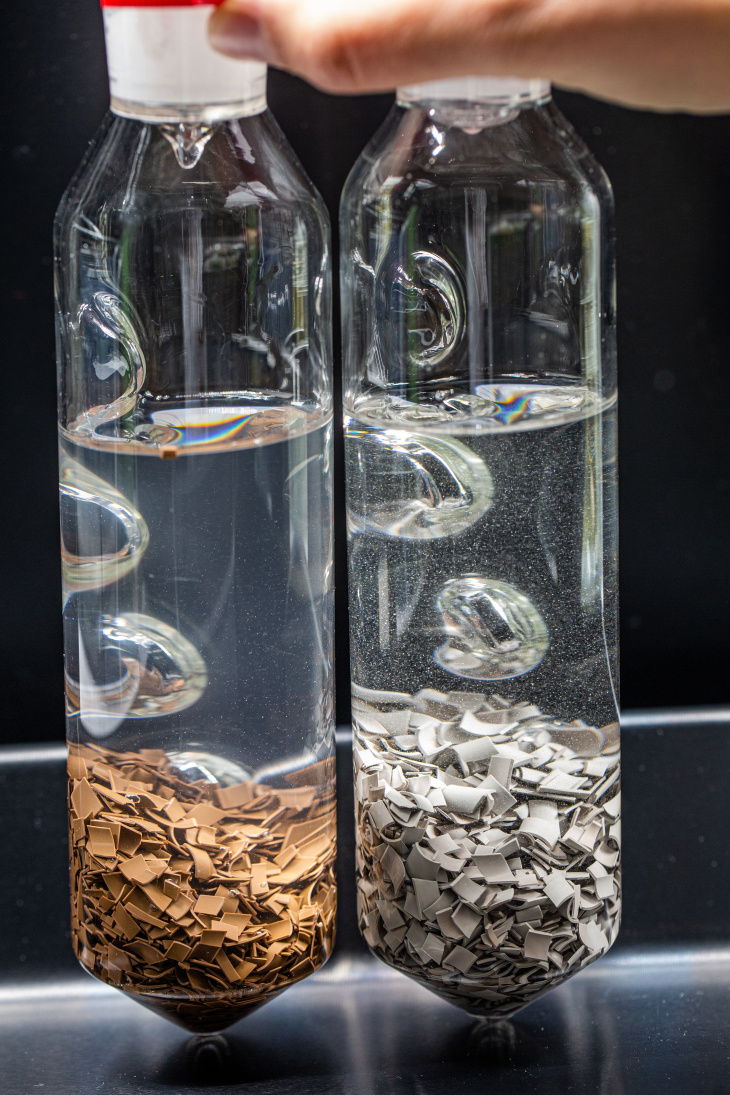Chemical cocktail from plastics
Plastic waste in rivers and oceans is constantly releasing chemicals into the water. Until now, it was unknown how large these quantities are and which substances are released particularly strongly. In the large-scale P-LEACH project, experts from four research institutes of the Helmholtz Association have now analyzed the composition and concentrations of many different substances. The main focus was on the question of how sun's UV radiation increases the release of chemicals.

Plastic waste floats in the sea. The plastics decompose over time and release chemicals into the environment. Photo: Unsplash/Naja Bertolt Jensen
Hundreds of thousands of tons of plastic waste are floating in rivers and oceans. The impact of waves, sun's UV radiation and salty seawater cause the plastic to gradually break down into smaller and smaller fragments and ultimately float in the oceans as tiny microplastic particles.
In numerous studies, researchers have investigated the extent to which marine animals ingest these particles and whether they become ill from them. Far less well researched to date is how the ingredients of various plastic products - including additives such as heavy metals, flame retardants, plasticizers, dyes and many other ingredients, that give plastic its versatile properties - affect marine life.
For this reason, more than 30 scientists joined forces two years ago in a major Helmholtz Association project to investigate in detail how quickly and to what extent plastic releases its additives into water - and to what extent these substances may harm marine life. The first project results of the experts from the Helmholtz-Zentrum Hereon in Geesthacht, the GEOMAR Helmholtz Centre for Ocean Research Kiel, the Alfred Wegener Institute, Helmholtz Centre for Polar and Marine Research (AWI) in Bremerhaven and the Helmholtz Centre for Environmental Research (UFZ) in Leipzig have now been published in the "Journal of Hazardous Materials".
The focus of this first research article from the P-LEACH consortium is on the chemical analysis of plastic ingredients - and the question of how the sun's UV radiation contributes to the release of chemical substances from plastics.
Focus on common types of plastic

Collection bin with plastic trash.
Photo: Annika Jahnke/UFZ
For their experiments, the scientists first bought eight typical mass-produced items made from frequently used plastics and cut them up into pieces just a few millimeters in size - including polyethylene (PE) greenhouse film, polyvinyl chloride (PVC) tubes and PET plugs. They then placed these pieces in a water bath and irradiated them with a special UV lamp that mimics sunlight over Central Europe for several months. For comparison, they stored some of the plastic in water containers that were not irradiated.
After the experiment, the plastic particles were removed using filters and the water was then thoroughly analyzed for possible release of tiny plastic particles and plastic additives - especially metal compounds and certain organic substances. Of particular interest were those chemicals that are suspected of being harmful to human health and the environment but are not banned or regulated.
The results were striking: considerably higher concentrations of metal ions were found in the water of UV-irradiated samples than in non-irradiated samples. The picture was more differentiated for the organic substances: some substances were also present in significantly higher concentrations in the UV-irradiated samples. For other organic molecules, however, concentrations were surprisingly low. "However, this is not an all-clear," says environmental chemist Dr. Frank Menger, first author of the research article and an expert in organic chemistry at Hereon. "We expect that these substances are also released from the plastic into the water, but then they are transformed into smaller organic compounds by UV light so that the original compounds are no longer directly detectable."
Search for known and unknown chemicals

The P-LEACH experiment setup.
Photo: Stefan Lips/UFZ
When analyzing the organic substances, the researchers examined two things in detail. Firstly, water samples were analyzed for 71 known substances that are well known to be used in many plastic products - including the UV protection molecule UV-328, which was added to the list of the Stockholm Convention a year ago - a list of particularly hazardous chemicals whose use is restricted or in some cases completely banned. The scientists also searched for unknown substances and degradation products in the water samples.
Special mass spectrometers were used for this purpose, which can recognize certain molecular structures or fragments of molecules to draw conclusions about the original substance. This also makes it possible to identify chemicals that are still relatively new to the market and relatively unknown - for example, new classes of plasticizers. Considering that around 16,000 different additives are used in plastic production worldwide, it becomes clear how challenging the analysis is, despite modern mass spectrometry.
Dr. Frank Menger is excited about the study scope and the entire project. "We brought together the analytical technologies and the relevant expertise from four research institutes." This was the only way it was possible to analyze water samples so comprehensively. Dr. Lars Hildebrandt, one of the Hereon scientists who worked on the complex analysis of microplastic particles and heavy metals as part of the study, adds: "I am hardly aware of any comparable studies to date in which the release of metal compounds as well as known and unknown organic compounds and also small plastic particles from plastic products have been investigated so extensively, with special consideration given to weathering caused by UV radiation."
However, it should be remembered that UV radiation is only one factor that affects plastic in the environment. There are also the salt content or degradation by microorganisms. The age, size, shape and porosity of the plastic also influence the extent to which additives enter the water. In this respect, further studies are needed in future that take these parameters into account and investigate their diverse effects.
"The P-LEACH project gives us a unique opportunity to comprehensively investigate release of organic and inorganic chemicals as well as microplastic particles from weathering plastic objects and possible effects, taking into account various disciplines such as environmental chemistry, ecotoxicology and human toxicology," says Prof. Dr. Annika Jahnke from the UFZ, who is coordinating the project. Further scientific articles by the P-LEACH team are due to be published in the coming months. These will include results on how the substances affect water contaminated with plastic substances affects bacteria, the metabolism of algae, snails and living cells, including cells from the human body.
Original publication
Original publication on ScienceDirect
More information
Institute of Coastal Environmental Chemistry Helmholtz Centre for Environmental Research P-LEACH
Contact
Scientist
Institute of Coastal Environmental Chemistry | Department Inorganic Environmental Chemistry
Phone: +49 (0) 4152 87-2211
